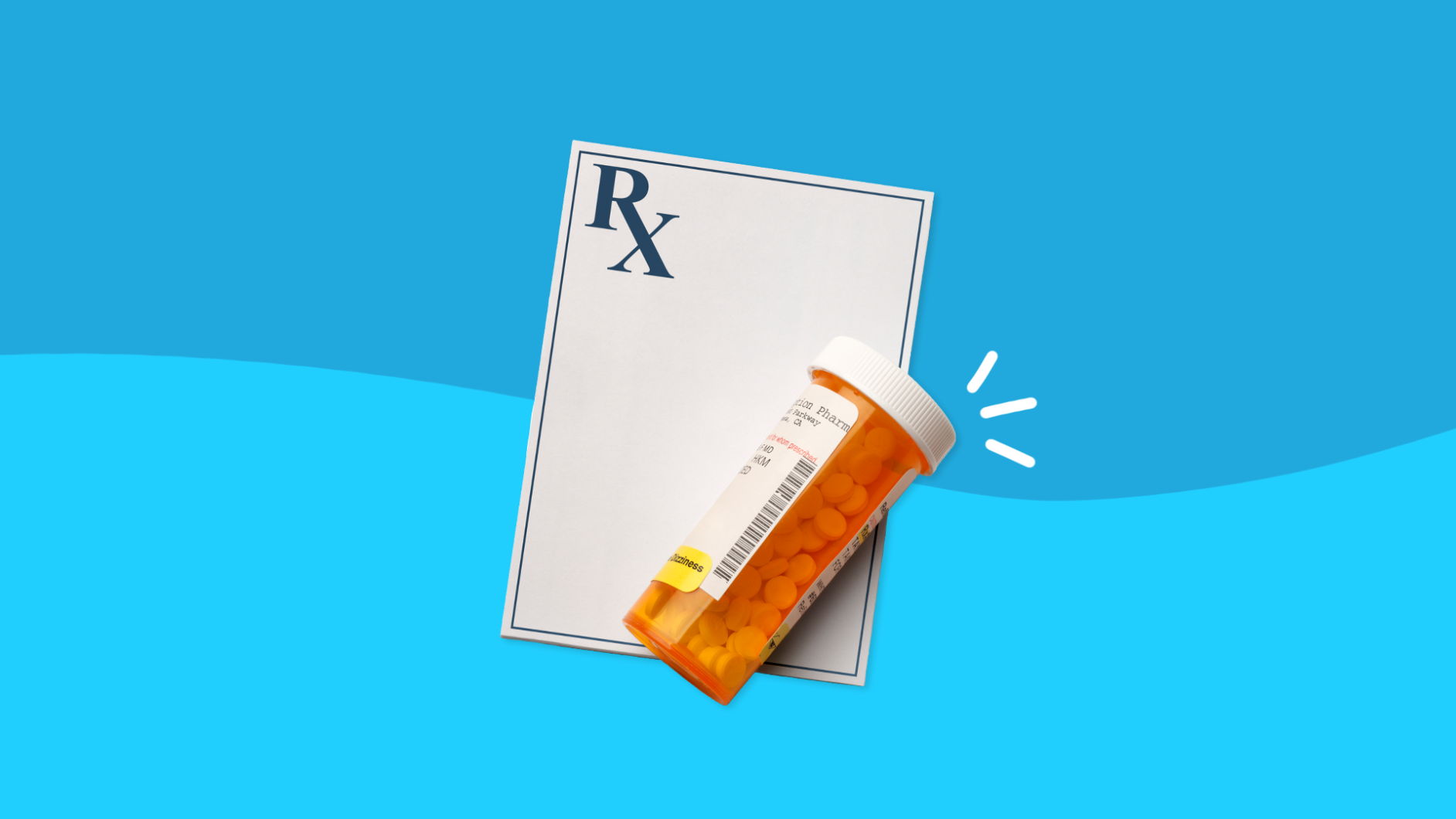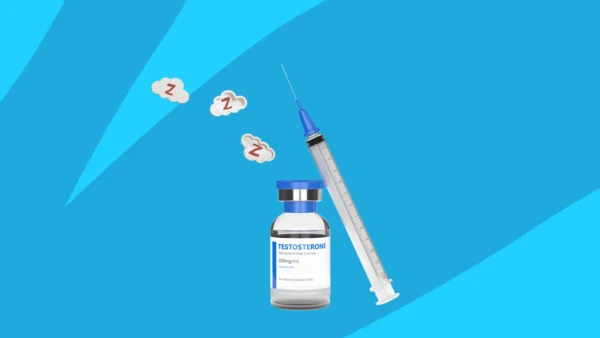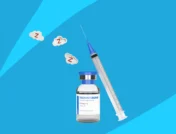Common side effects | Serious side effects | Warnings | Interactions | How to take finasteride | How to avoid side effects | Alternatives | FAQs
Finasteride is a steroid-like medication frequently prescribed to treat benign prostatic hyperplasia (enlarged prostate) and male pattern baldness. You’ll most likely find it in medicine cabinets and pharmacies as the brand names Proscar or Propecia, although a generic version is also available.
The drug works by preventing the conversion of testosterone to dihydrotestosterone (DHT), a hormone that causes prostate gland growth and hair follicle shrinkage. By blocking this conversion, the medication successfully decreases prostate size for most patients, and two-thirds of men taking it for hair loss report regrowth. While certain finasteride studies have suggested female hair restoration as well, it’s prescribed with caution in women, and should be avoided entirely in pregnant women as it can cause serious birth defects in an unborn baby.
Simultaneous treatment of male pattern hair loss and BPH, two widespread concerns for men, makes finasteride tablets seem like a male health Superdrug. So is it? While it’s incredibly useful, finasteride isn’t perfect. Look beyond the surface-level benefits, and you’ll find various possible side effects, warnings, and drug interactions. Read on for an in-depth look at all three.
RELATED: What is Proscar? | What is Propecia? | What is Finasteride?
Want the best price on finasteride?
Sign up for finasteride price alerts and find out when the price changes!
Side effects of finasteride
Propecia and Proscar are prescription drugs that are generally well-tolerated, but they come with a whole range of potential side effects. Finasteride belongs to a drug class called 5-alpha-reductase inhibitors, which affect hormone levels and alter male hormone activity, occasionally causing reproductive side effects like:
- Impotence/erectile dysfunction (reversed with discontinuation of medication)
- Ejaculation disorder
- Decreased volume of ejaculate
- Reduced sperm count
- Reduced sex drive
In addition to the side effects listed above, other common side effects reported with an incidence of approximately 1%-10% of patients taking the medication include:
- Orthostatic hypotension (low blood pressure upon standing)
- Dizziness
- Headache
- Weakness
Finally, possible side effects, generally observed in less than 1%-2% of patients taking finasteride, include:
- Runny nose
- Skin rash
- Low blood pressure
- Testicular pain
- Breast tenderness
Patients taking finasteride might also experience increased urination. However, in the treatment of BPH (which often restricts urination), this can represent a return to healthy urinary flow.
Try the SingleCare discount card
Serious side effects of finasteride
Common finasteride side effects are enough to be an inconvenience, but they’re nothing out of the ordinary for prescription medications. In rare cases, however, more severe side effects can occur that may be signs of a serious condition and require medical attention. These include:
- Persistent erectile dysfunction: In a recent clinical study, 1.4% of men who began 5-alpha-reductase inhibitor treatment developed sexual dysfunction that persisted at least 90 days after ceasing the medication. It’s not permanent impotence like some media sources have reported, but it can affect day-to-day sex life during and extended periods after treatment ends.
- Infertility: To be clear, this isn’t life-long infertility. Some men may experience poor semen quality while taking finasteride, which typically improves after discontinuation of the medication.
- Depression: Finasteride can cause alterations to the hippocampus, which processes emotional responses, leading to depressive states and suicidal thoughts. Stress and anxiety can also stem from potentially inhibited sexual function.
- Increased risk of breast cancer: Certain studies have questioned a connection between finasteride therapy and reports of breast cancer in men, while others have found no correlation. Still, anyone taking the drug should be aware of cancer indicators like breast enlargement, swelling, pain, lumps, or nipple discharge, and visit a doctor if these side effects persist.
- Higher risk of high-grade prostate cancer: According to a study by the New England Journal of Medicine, finasteride reduces the risk of low-grade prostate cancer, but can increase the risk of high-grade prostate cancer. Long-term outcomes revealed no difference in survival outcomes comparing patients receiving finasteride versus placebo, and a presumed contributor to this finding is that finasteride actually improves the ability to detect this type of cancer.
- Allergic reaction: In rare cases, finasteride can cause a severe allergic reaction. Indicators like hives, difficulty breathing, and tongue or throat swelling warrant immediate medical attention.
Vision problems aren’t a typical finasteride side effect, although one study found a correlation. However, it was a fairly small sample size, so further testing might be necessary for confirmation. But this doesn’t mean it’s completely harmless to your vision. According to Dr. Yuna Rapaport, MD, MPH, the director of Manhattan Eye, “finasteride itself can cause subclinical damage to the retina and optic nerve, which may not affect your actual vision, but could be discovered on a special image.” Additionally, comparable prostate medications like Flomax can “affect the way the iris constricts and makes certain surgeries, particularly cataract surgery, more challenging.”
Memory loss may be a concern, mainly because dihydrotestosterone affects cognitive function. The Journal of Neurological Sciences found higher risks of dementia during the first two years of 5-alpha reductase inhibitor therapy, but no increased risk after that.
After experiencing (or reading about) some of these side effects, some men will want to cut off their finasteride treatment. There aren’t any severe consequences or withdrawals after quitting finasteride cold turkey, but hair loss and prostate growth will likely resume unless another treatment takes its place.
Finasteride warnings
Generally, finasteride is a safe treatment option. That said, perhaps the biggest takeaway from all these side effects is that it’s not for everybody. According to the Propecia drug information from its manufacturer, Merck, and the Food and Drug Administration (FDA), finasteride “is not indicated for use in women or pediatric patients.” And this is especially true for pregnant women. The drug’s effect on unborn male children can be so detrimental that the FDA warns expecting mothers against even handling broken or crushed Propecia tablets.
Anyone with pre-existing liver disease or liver function abnormality should exercise caution when using finasteride because it’s primarily metabolized in the liver. No specific dose adjustments are advised.
There are two standard finasteride dosages: 1 mg and 5 mg. When used for hair growth in patients with male pattern baldness or androgenetic alopecia, doctors typically prescribe 1 mg tablets, while BPH patients often require 5 mg. Doses larger than 5 mg are not recommended.
Although finasteride can treat hair loss, continued use is required to maintain its effects. A patient who begins finasteride treatment sees results, then stops, and will see those results reverse. The 1 mg dose is safe for long-term use, but can also cause extended side effects.
Finasteride interactions
Despite its side effects and warnings, finasteride tablets haven’t shown significant interactions with any other drugs in clinical trials. Still, there are common questions about taking certain common medications alongside Propecia or Proscar.
Patients who worry about finasteride’s propensity to cause erectile dysfunction (ED) and other reproductive disorders might wonder if they can take it simultaneously with Viagra, Cialis, or other ED drugs. The answer is yes. Not only can they be used together, but simultaneous use could help mitigate or prevent certain sexual side effects.
But what about other hair growth treatments like Rogaine (minoxidil) or biotin? Yes, both of these are safe for simultaneous use with finasteride. Keep in mind, however, that Rogaine has its own set of side effects, which a patient might experience alongside finasteride side effects.
Testosterone replacement treatment is also safe for use with finasteride in patients with low testosterone.
And what about alcohol? Generally, alcohol and finasteride are a safe combination. However, certain studies show that daily, heavy drinking can increase the risk of high-grade prostate cancer, as does finasteride. So, using this drug with high daily alcohol consumption theoretically may compound the risk.
How and when to take finasteride
Finasteride can be taken with or without meals. The typical dose of finasteride is highly dependent on indication; for male pattern hair loss the dose is typically 1mg by mouth once daily, while higher doses 5 mg by mouth once daily are used for BPH. If a dose is missed, take the dose at your next regularly scheduled administration time. Overdosage of finasteride should be avoided, and if occurs one should seek medical help and contact Poison Control.
How to avoid finasteride side effects
Unfortunately, side effects aren’t always avoidable. Sometimes, they just happen. Still, some measures and precautions can reduce the risk of finasteride side effects.
The most basic precaution is to take the medication as prescribed by a healthcare professional. Patients can take it with or without food, but should only take one dose per day (any time of day). Typically, the drug’s effects aren’t visible for three months, after which consistent use is necessary for sustained benefits.
Also, keep in mind that some side effects might only be temporary. “The side effects can diminish as you continue to take the medication, and they completely subside after you stop the medication,” according to Dr. Rapaport. So, patients experiencing adverse events can often stop them by ceasing the medication. There are some instances of sexual dysfunction that might persist longer before eventually tapering off.
The bottom line is this: Do finasteride’s benefits outweigh the potential side effects? But the answer isn’t simple. It varies for each person, depending on their condition, medical history, priorities, and more. The best move for anyone considering a medication like Propecia or Proscar is to get medical advice from a doctor.
Finasteride alternatives
Finasteride is just one treatment option for both BPH and androgenetic alopecia. When managing symptoms of BPH, non-pharmacologic options should always be part of the approach. Limiting fluids before bedtime, as well as limiting alcohol and caffeine in general might help control symptoms. Another medication in the 5-alpha reductase inhibitor class includes Avodart, but entirely different classes of medication are also available. Alpha-blockers are initial therapy for moderate to severe symptoms, after which 5-alpha-reductase inhibitors are added on if patients have an unsatisfactory response after 4 to 12 weeks. A combination medication, including an alpha-blocker and a 5-alpha-reductase inhibitor, is available as Jalyn. When it comes to male pattern baldness, topical medications like Rogain is an alternative to finasteride. Supplements, like Nioxin and Nutrafol, often include combinations of ingredients like biotin and collagen, but there really isn’t robust data to support their use.
RELATED: How much is finasteride without insurance?
Finasteride FAQs
Are there any permanent side effects of finasteride?
An extensive review of literature has made the case for a phenomenon known as Post-finasteride Syndrome (PFS) which is described as encompassing a group of serious side effects that develop and then persist in patients taking finasteride and/or after discontinuing treatment. The proposed constellation of side effects includes irreversible sexual, neurological, physical, and mental issues. Because clinical trials have not been established to specifically study the permanence of these side effects, it is difficult to definitively establish a causal relationship. However, one should be aware of the potential of this phenomenon when embarking on a treatment plan which includes finasteride.
What are the cons of finasteride?
The sexual side effects that are commonly experienced with finasteride are big cons to be weighed against the benefits of use of the medication, especially since there is concern that these side effects may also cause or exacerbate additional mental health conditions such as depression or suicidal ideation. Additionally, in 2011 the FDA issued a Safety Announcement informing healthcare professionals that the labeling for 5-alpha reductase inhibitors, including finasteride, had been revised to include new safety information on the increased risk of developing high-grade prostate cancer.
Is finasteride used in women? Are there different side effects when used by women?
Finasteride can and has been used in women for management of hair loss as an off-label indication, but it should be initiated with great caution. Finasteride is teratogenic, meaning it is known to cause fetal developmental malformations. Because 50% of pregnancies are unplanned, it is risky for a woman within the broad child-bearing age range to take this medication. In fact, it is recommended that women do not even handle the medication at all given the risk to a developing fetus. Ideally, finasteride should only be considered a treatment option for female pattern hair loss in postmenopausal women.
Side effects in women may differ slightly from those experienced by males. Sexual side effects are less common to occur in women taking finasteride but have been reported. Women may experience side effects related to changes in their menstrual cycle and excess body hair growth, or hirsutism. Similar to side effects experienced by men, women may also develop changes in their mood and breast tenderness. Fortunately, limited data support that these side effects in women are reversible when the medication is discontinued.
Will I need to use finasteride long term?
To see the maximal benefits of finasteride, it might take a full year of consistent use. For BPH, a minimum of 6 months of treatment will be necessary to determine whether or not a male is responding to treatment. For male pattern baldness, at least 3 months of consistent use need to pass before a response can be observed. In androgenetic alopecia, it’s best to start treatment earlier than later. Unfortunately, if you stop taking the medication the benefits in prostate size reduction and hair growth will reverse. Therefore, taking finasteride long-term is definitely a likely scenario.
How long does finasteride take to work?
The benefits of finasteride for reducing prostate size and/or increasing hair growth are not going to be an overnight phenomenon. In fact, it will take around 3 months to start noticing effects and up to 6 to 12 months of consistent use to start noticing maximum effects
How long does finasteride stay in your system?
Most medications stay in the body for 3-5 half-lives, or the time it takes for the body to rid the medication via metabolism and elimination by half. The half-life for finasteride is approximately five to six hours, so one should expect the body to completely eliminate the medication within one or two days.











